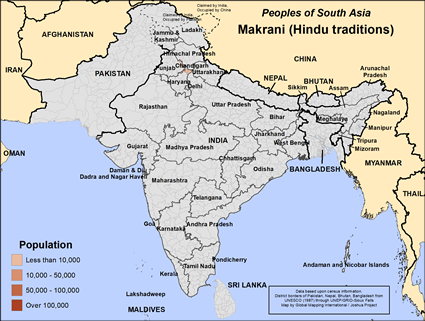Historically, the Makrani have worked in occupations related to agriculture, fishing, and small-scale trade. Their community has long played a role in the local economy, adapting to changes in the region while maintaining strong ties to traditional occupations. Over time, some Makrani families have sought work in urban centers, but many remain engaged in their ancestral trades.
Most Makrani families continue to rely on fishing and agriculture to support themselves. Those living near the coast primarily work as fishermen, while inland communities engage in farming, growing crops like rice, millet and wheat. The community often works together, with extended families managing both household and work-related responsibilities. In addition to these traditional occupations, some Makrani families have taken up small-scale trading and labor in nearby towns.
Their villages are typically composed of close-knit communities, with homes constructed from mud, brick and thatch. The daily rhythm of life revolves around work, religious observances and family. While younger generations sometimes migrate to cities for education or employment, many return to their villages during busy agricultural or fishing seasons to assist their families.
The Makrani people practice Hinduism, worshiping deities such as Vishnu, Shiva and Durga. Religious observances play an important role in their lives, with festivals like Diwali, Holi and Navratri being major community events. They also honor local gods and goddesses associated with nature and the sea, reflecting their dependence on both land and water for their livelihood.
Temples and shrines serve as central places for worship, where families gather to offer prayers and perform rituals for protection, success and prosperity in their work. Their religious practices often reflect the cycles of nature, with prayers for a successful fishing season or a bountiful harvest.
The Makrani people face several challenges, particularly in terms of economic development, education and healthcare. Many rely on traditional methods of farming and fishing, which leaves them vulnerable to environmental changes such as droughts or shifts in fish populations. Access to modern fishing equipment, sustainable practices, and improved irrigation systems could enhance their economic stability.
Education remains a critical need, especially in rural areas where access to quality schools is limited. Expanding educational opportunities would allow the younger generation to pursue careers beyond manual labor and traditional occupations. Healthcare services are also limited, with many Makrani families traveling long distances to access basic medical care. Programs that improve healthcare access and provide educational support would greatly benefit the community.
Pray for the Lord to reveal himself as savior and friend to the Makrani people.
Pray for laborers to be sent to these people with a passion to see them come to salvation in Christ.
Pray that the Holy Spirit would be opening and preparing their hearts to receive the gospel.
Pray that they would not see Christianity as an outside movement or religion, but they would see salvation as God's redemption plan that he's offered all along.
Pray for discipleship communities to grow and thrive among the Makrani people.
Scripture Prayers for the Makrani (Hindu traditions) in India.
Ethnologue: Languages of the World
Reports from Indian NGOs on fishing and agricultural communities
| Profile Source: Joshua Project |











